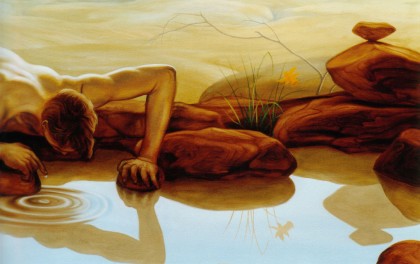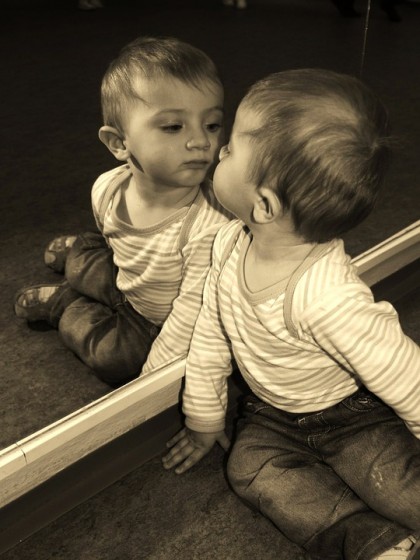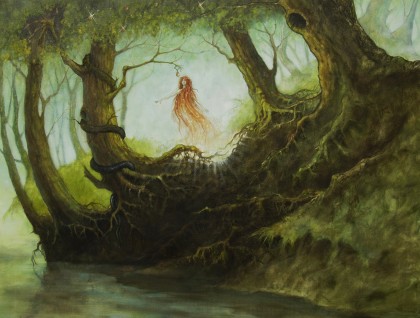The Alongside Woman on Your Screen
Devra Torres | Nov 1, 2016 | 1 cmt
I'm reading Perelandra--the second volume of C. S. Lewis' space trilogy--to the kids these days. Do read the whole thing yourself! But for now, here's just enough of a backstory so this post will make some sense.

Ransom, a kindly philologist, has been sent to Perelandra (or Venus) in order to head off the corruption of a still-unfallen race. There the Evil One has his representative in the mad scientist, Weston. Early in the story, Weston calls the powers of evil into himself, and they take him up on it. He's attempting to ensnare the woman by tempting her to vanity, with the help of a pocket mirror brought from Earth. Unexpectedly, she's terrified. He tries to reassure her:
"But there is no cause for fear in this little thing: rather for joy. What is fearful in it?”
“Things being two when they are one,” replied the Lady decisively. “That thing” (she pointed at the mirror) “is me and not me.”
“But if you do not look you will never know how beautiful you are.”
“It comes into my mind, Stranger,” she answered, “that a fruit does not eat itself, and a man cannot be together with himself.”
The corpse-like creature then continues administering the temptation to self-worship, cunningly mixed with a large dose of truth about how the powers of reflection and self-knowledge set man apart.
“A fruit cannot do that because it is only a fruit,” said the Un-man. “But we can do it. We call this thing a mirror. A man can love himself, and be together with himself. That is what it means to be a man or a woman—to walk alongside oneself as if one were a second person and to delight in one’s own beauty. Mirrors were made to teach this art.”
[...] She took the mirror, timidly but firmly, from the Un-man and looked into it in silence for the better part of a minute. Then she let it sink and stood holding it at her side.
“It is very strange,” she said at last.
“It is very beautiful,” said the Un-man. “Do you not think so?”
“Yes. “
“But you have not yet found what you set out to find.”
“What was that? I have forgotten.”
“Whether the robe of feathers made you more beautiful or less."
“I saw only a face.”
“Hold it further away and you will see the whole of the alongside woman—the other who is yourself. Or no—I will hold it.”
The commonplace suggestions of the scene became grotesque at this stage. She looked at herself first with the robe, then without it, then with it again; finally she decided against it and threw it away.
My first meeting with Perelandra was when my mother read it to my sister and me. I was old enough to be enthralled by the plot, but I didn't get this part at all.
 I think it would be easier to get now, with the reign of social media. Now I carry the Alongside Woman in my pocket wherever I go. Sometimes I modify her, by changing my profile picture of my cover photo. Sometimes I improve her with Snapseed or other photo-editing software, to make her look a little younger or more interesting. Sometimes I'm preoccupied with how she comes across, so I edit the posts she writes to make her sound more carefree, or intelligent, or mentally balanced. Sometimes she's very heavy to lug around, and sometimes the line between her and me blurs and I don't even notice she's there.
I think it would be easier to get now, with the reign of social media. Now I carry the Alongside Woman in my pocket wherever I go. Sometimes I modify her, by changing my profile picture of my cover photo. Sometimes I improve her with Snapseed or other photo-editing software, to make her look a little younger or more interesting. Sometimes I'm preoccupied with how she comes across, so I edit the posts she writes to make her sound more carefree, or intelligent, or mentally balanced. Sometimes she's very heavy to lug around, and sometimes the line between her and me blurs and I don't even notice she's there.
Of course people have cultivated artificial images of themselves as long as there have been selves--or fallen ones, anyway.
These days, though, you don't have to take an imaginary journey to another planet to see how much havoc the Alongside Woman (or the Alongside Man) can wreak.



Comments (1)
Sam Roeble
Nov 2, 2016 9:24am
Great topic Devra for Halloween/All soul's Day! I took a different approach with Perelandra here. I trace Ransom's view of Weston:
1) Man as humane
2) Sick man with vestiges of original humanity
3) Thing
4) The Un-Man
*Nota bene: Ransom never stops interceding for Weston's person, despite being possessed